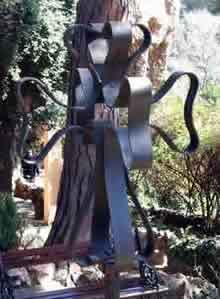Our first day as tourists in Barcelona, I discovered Gaudi's cross. Tim and I were touring the city with Ric and Frieda Escobar. Since they only had one day to enjoy the sites, we decided to take the double-decker tour bus that stopped at most of the major landmarks around the city. As we drove past some of the most notable creations by the Art Nouveau architect Antoní Gaudí, the Casa Batlló and La Pedrera, I was captivated and glad that Tim and I had planned a few more days in the city so we could go back and spend more time there.
We got off the bus at the Sagrada Familia cathedral. Frieda wanted to go inside and I was more than happy to accompany her. Up to that point I had found Gaudi's architecture aesthetically appealing, but as I looked up at the immense interior columns, whose design and geometrically expanding form (they split from one to four to sixteen) made me feel like I was in something built by the Elves in the Lord of the Rings, I began to appreciate that his architecture went much deeper than the aesthetic; his work communicates a powerful, creative, God-centered world view.

The impressive interior columns and vaults of Gaudi's
"Sagrada Familia" -- the only cathedral in the world
still under construction
 Later that day in Güell Park, I noticed an interesting metal cross in the garden in front of a house owned by Gaudí himself. I stood for a few minutes taking in this unique cross. I was so struck by the cross I knew I should have taken a picture of it, but it was raining and I didn't have the camera on me, so I let it go. I found this picture on-line so at least you can get an idea.
Later that day in Güell Park, I noticed an interesting metal cross in the garden in front of a house owned by Gaudí himself. I stood for a few minutes taking in this unique cross. I was so struck by the cross I knew I should have taken a picture of it, but it was raining and I didn't have the camera on me, so I let it go. I found this picture on-line so at least you can get an idea.(picture from www.dgolds.com/photos)
As you can see, its most striking feature is its dimension, the way it looks like the intersection of two perpendicular crosses.
I had been doing a lot of thinking about how followers of Christ can communicate their faith in the changing cultural environment, especially how people like me who love words, especially written words, can connect with people who, more and more, are impacted by the visual and the experiential than they are by written words. The answer - that we need to be living examples of what it means to follow Christ-is nothing new; God himself modeled it when he became a man. But in Gaudi's cross I found an image of this incarnational apologetic.
It is impossible to create an accurate two-dimensional representation of this cross; it must be seen in 3-D for it to be the same cross. In the same way, our faith must be lived or it is just a degraded copy, a thin shadow of the real.

Here I am under another style of 4-armed cross
on the roof of Gaudi's magnificent apartment
complex called "La Pedrera" (the rock quarry)
In an interview with Vicente A. Salaverri Gaudí said:
Men are divided into two categories: men of words and men of action. The former talk, the latter act. I belong to the second group. I lack the means of expressing myself. I could not tell you about the concept of art. I need to give it a concrete form.

No comments:
Post a Comment